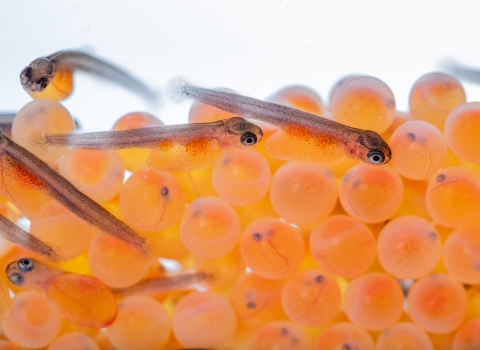What We Do
Wolf Creek National Fish Hatchery is administered by the U.S. Fish and Wildlife Service and is supported by federal tax dollars. Fish raised in federal hatcheries are stocked in public waters to support federal fishery responsibilities mandated by law. These responsibilities include:
- to provide fish for mitigation where, for example, human-made dams have prevented fish from reaching their spawning habitat;
- to recover threatened or endangered populations;
- to restore interjurisdictional fish populations, or to support depleted recreational fish populations in federal and state waters.
Over a century ago, society recognized that conservation measures were necessary to maintain sustainable fishing in our public waters. Fishing has always been one of America’s leading forms of outdoor recreation. The primary responsibility of the Wolf Creek National Fish Hatchery is to raise rainbow, brown, and brook trout which will help preserve this tradition for present and future generations of Americans.
Construction of a dam, regardless of its type, alters the entire river ecosystem. The first and most obvious change takes place when the reservoir fills, but many changes take place below the dam.
Wolf Creek Dam produces a large, deep reservoir in which the water stratifies into temperature layers during the summer and fall months. The water released into the Cumberland River comes from a deep, cool layer, which replaced the original warm water fish habitat with a “cold tailwater”.
Management and Conservation
This station does not conduct spawning operations. Other federal hatcheries in Tennessee, West Virginia, Wyoming, and Montana hold breeding populations which are artificially spawned. After the eggs are collected and fertilized, they are held at the station until they develop to the eyed egg stage. The eggs are then shipped overnight to production hatcheries like Wolf Creek National Fish Hatchery to hatch. When the station receives eggs they are disinfected to prevent the spread of fish diseases. The eggs are counted using volumetric displacement and then placed in hatching jars.
Eggs hatch approximately 10-14 days later. The fry are then transferred to rearing tanks where they remain another 10-14 days until they absorb their nutrient dense yolk sacs. As the yolk sacs are absorbed, the fry swim to the water surface and are fed specially formulated feed hourly. When the young fry reach approximately 2 inches they are called fingerlings. When the fingerlings grow 2-3 inches they are moved to the outside raceways where the larger fish are kept.
Our Services
Fish production
Rainbow trout
- 20,550 lbs. - 15,000 fish at 15 inches
- 8,500 lbs. - 12,325 fish at 12 inches
- 49,300 lbs. - 120,750 fish at 10 inches
- 152,000 lbs. - 483,600 fish at 9 inches
Brown trout
- 8,300 lbs. - 12,000 fish at 12 inches
- 11,925 lbs. - 57,150 fish at 8 inches
Brook trout
- 4,600 lbs. - 15,000 fish at 9 inches
- 4 lbs. - 300 fish at 3 inches
Our Projects and Research
Wolf Creek National Fish Hatchery raises rainbow, brook and brown trout to support recreational fisheries that have been impacted by federal dams. Over a century ago, environmentalists recognized that conservation measures were necessary to maintain good fishing opportunities in our public waters, the fish that Wolf Creek raises...


